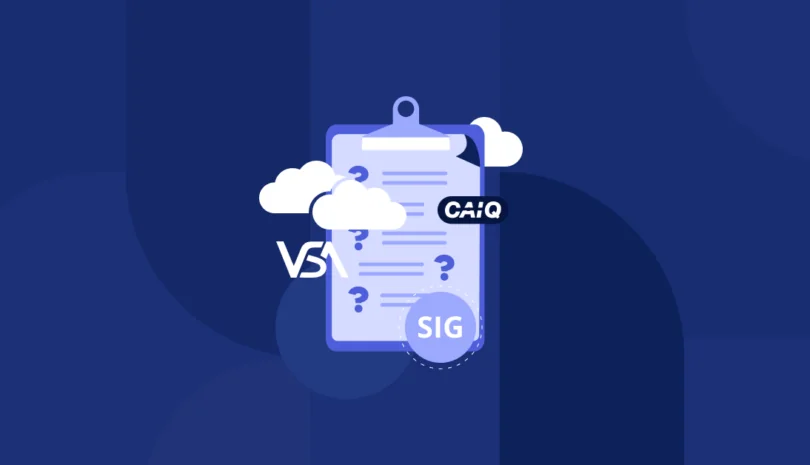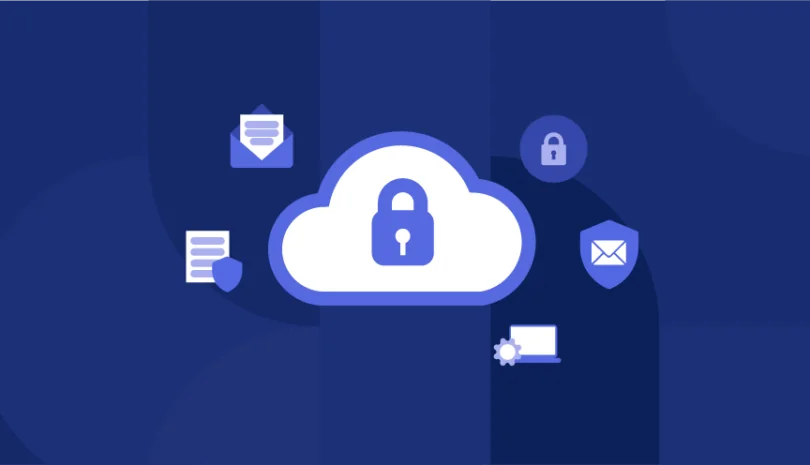More than half of CISOs admitted to their organizations suffering from ransomware attacks, the most common type of third-party breaches (27% of all attacks), according to a report by Black Kite from 2021. Unauthorized breaches came in second (15% of all attacks), with unsecured servers and databases coming in third (12% of breaches). The combined increase in dependence on vendors in today’s interconnected world with the prevalence of data breaches mean that vendor risk assessments are more essential than ever.
What is a Vendor Risk Assessment?
A vendor risk assessment examines the strength of the cybersecurity controls a business or third-party service provider has implemented to understand its residual risk. Businesses conduct vendor risk assessments to understand the risk a current or potential vendor poses. Once defined and risks have been remediated, the company can proceed or continue to have a business relationship with those vendors.
Vendors risk can be classified into two main categories:
- Low-risk vendors. These vendors pose a low inherent risk to your organization. A vendor that delivers paper towels to a business is a good example of a low-risk vendor, since this vendor is not sharing data with your business.
- High-risk vendors. These vendors pose a high inherent risk to your organization, and your business should spend resources checking what type of cyber controls they have in place to minimize risk . A credit card processor that handles millions of credit cards is a good example of a high-risk vendor, since your business must share vast amounts of personal sensitive information with it. This exposes your organization to a potential data breach that can take down critical systems, incur lawsuits, and cost your organization in both fines and reputation.
Why is a Vendor Risk Assessment Important?
While vendor relationships provide obvious benefits, it’s important to be mindful of the risks they bring as well. Do your due diligence, evaluate vendor cyber risk of potential vendors before the procurement process, and then decide whether or not to work with a particular vendor. Since new risks evolve constantly, you’ll also want to ensure your third parties are maintaining a good security posture by conducting vendor risk assessments at regular intervals.
Just the thought of performing vendor risk assessments can be overwhelming, but failing to do them may result in much worse: lost business, reputational damage, non-compliance or legal fees and fines.
In contrast, a proper vendor assessment offers many benefits to businesses and their third-party service providers, including:
- Better risk management. When vendors are tiered according to risk level, it’s easier for your business to see the big picture to minimize and remediate risk.
- A reduction in costs. Streamlining systems and more effective risk management decreases the chance of a breach and any associated non-compliance fines and that can cost your organization in time and resources.
- Easier to meet regulatory compliance. Your ability to meet compliance is dependent on the ability of your third parties to meet compliance. As a result, it’s critical to properly manage your third-party service providers.
- Defense against data breaches. In the event of a data breach, you’ll need to show proof that your business has a vendor risk management program and that it has done its due diligence.
What are the Main Types of Vendor Risks?
Each vendor relationship has different risk criteria that your organization needs to evaluate according to the level of risk it is able to tolerate. These evaluations may differ depending on the type of vendor risk they pose to your organization.
These may include:
- Cybersecurity risks. Can your vendors’ technology be easily exploited? Are employees knowledgeable about cybersecurity best practices so that they provide a first line of defense for the organization?Are employees knowledgeable about cybersecurity best practices so that they provide a first line of defense for the organization?
- Operational risks. Can this vendor deliver on time? Do you have a plan in place in the event that they suddenly stop operations?
- Geographic risk. Are they in a location where operations could be disrupted by any natural disasters (e.g. earthquakes, floods, volcanos)?
- Financial risks. Is the vendor suffering from recent layoffs or poor operations? Is there a risk of bankruptcy in the near future?
- Compliance risks. Are they meeting regulatory compliance for their industry?
- Reputational risks. Is the vendor in the news for poor performance or unethical actions? Are they facing legal action? Your business might want to steer away from doing business with vendors with negative publicity.
How to Develop an Effective Vendor Risk Assessment Process
How can you be sure that your vendor cyber risk assessments are effective? Here are five key steps that you should be sure to include in your vendor risk assessment process:
1. Understand your vendors’ impact on your organization.
In order to understand the inherent risk of each vendor, do the following:
- Examine the current security measures your vendor has in place, what must be secured and how, the highest risk areas and how the impact poses risk to your organization.
- Understand the business implications a vendor breach would have on your organization. For example; would a sudden vendor loss disrupt your business or affect your customers?
The above considerations will help explain how your vendors’ risks can potentially affect your organization based on your business relationship with the vendor. Given this information, you can make informed decisions about the scope of the assessment.
2. Analyze the attack surface of your vendors.
Scanning your vendors’ public-facing digital footprint is critical so that you can discover their assets and any possible cyber gaps. Any analysis should examine at least three layers:
- IT and network: parameters involving DNS servers, SSL-related protocols and more
- Applications: parameters involving Web applications, domain hijacking and more
- Human: parameters involving social posture, presence of a dedicated security team and more
Keep in mind that performing a comprehensive review of the vendor’s attack surface requires specific engineering and security know-how. Panorays can help by unveiling assets while running tests in parallel with the least amount of false positives. This will allow you to quickly review many vendors at once and significantly accelerate and scale this process.
3. Customize security questionnaires according to risk level.
Answering questionnaires is a lengthy process that often involves multiple team members on the vendor side. Obviously, it’s not helpful to require them to complete security questionnaires that contain a lot of irrelevant questions.
To streamline the process, it’s best to customize questionnaires according to the business relationship that your company has with the vendor. For example, some vendors will need to comply with regulations such as GDPR and NYDFS, which means that they will need to respond to specific questions that assess their regulatory readiness.
Manually creating customized questionnaires for each vendor can be extremely time-consuming. Using an automated solution like Panorays, you can rapidly generate automated questionnaires based on your company’s business relationship with vendors.
4. Review responses and create remediation timelines for vendors.
Once you gather all of the responses from the questionnaires, which can easily include hundreds of responses per questionnaire, you need to carefully review each response and flag any issues. Using automation can greatly reduce the amount of time spent on this step.
This is also the time to determine whether any cyber gaps must be remediated. If so, you will need to present a remediation plan and timeline to your vendors according to your organization’s guidelines.
5. Continuously monitor your vendors for changes to cyber posture.
Your vendors may be cyber gap-free when you onboard them, but that could change. Hackers constantly use new and advanced methods to exploit new vulnerabilities and engage in cyberattacks. Moreover, vendors frequently add new assets and software and may change their internal reasons. For these reasons, it’s important to continuously monitor your third parties and receive live alerts about any issues.
How Panorays Can Help Your Third-Party Risk Assessment
In an age where the average organization shares its data with 730 third party vendors, effective vendor risk management is more critical than ever. Panorays automates your vendor risk management process, giving you an overview of your suppliers’ cyber posture immediately, and questionnaire response time typically takes just nine days.
Want to learn more about how to perform effective vendor risk assessments? Open a free account today!
FAQs
Vendor risk assessments help your organization evaluate the potential vendor risk of doing business with an organization. You can then decide whether to work with them or work with them pending remediation. Or you may decide that it’s not worth taking on the risk of working with them at all.
A vendor risk assessment should enable you to:
1. Understand your vendors’ impact on your organization. Examine the inherent risk by asking what the current security measures are that your vendor has in place and what areas pose the highest risk.
2. Analyze the attack surface of your vendors. Your vendor’s digital footprint should be assessed to discover any security gaps to include three levels: your IT and network; applications; and human.
3. Customize security questionnaires according to risk level. Streamline the process with vendor risk assessment templates that can be customized according to the business relationship that your company has with the vendor.
4. Review responses and create remediation timelines for vendors. Review each response and flag any issues using automation to reduce the amount of time spent on this step.
5. Continuously monitor your vendors for changes to cyber posture. Hackers are constantly exploiting new vulnerabilities, so make sure you continuously monitor your third parties and receive alerts about any new security issues.
Vendor risk assessments help organizations evaluate the risk a vendor or third party poses to them when using their product or service. They give businesses an understanding of the risks posed by their vendors so they can manage risk better, reduce costs, provide a defense against data breaches and ease regulatory compliance.
This post was originally published on December 9, 2020, and has been updated to include fresh content.



